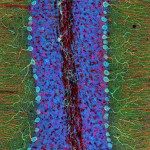Lien vers Pubmed [PMID] – 24687185
J. Cell. Sci. 2014 Apr;127(Pt 7):1359-67
For many years, β-arrestins have been known to be involved in G-protein-coupled receptor (GPCR) desensitization. However, β-arrestins belong to a family of proteins that act as multifunctional scaffolding proteins, in particular during trafficking of transmembrane receptors. The arrestin family comprises visual arrestins, β-arrestins and α-arrestins. In mammals, the functions of the α-arrestins are beginning to be elucidated, and they are described as versatile adaptors that link GPCRs or the Notch receptor to E3 ubiquitin ligases and endocytic factors. These α-arrestins can act in sequence, complementarily or cooperatively with β-arrestins in trafficking and ubiquitylation events. This Commentary will summarize the recent advances in our understanding of the functions and properties of these α-arrestin proteins in comparison to β-arrestins, and will highlight a new hypothesis linking their functional complementarity to their physical interactions. α- and β-arrestins could form transient and versatile heterodimers that form a bridge between cargo and E3 ubiquitin ligases, thus allowing trafficking to proceed.


